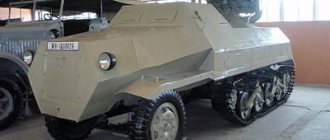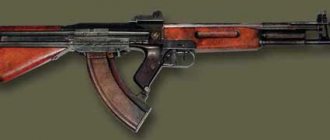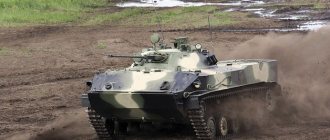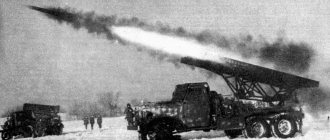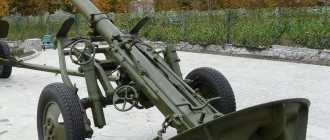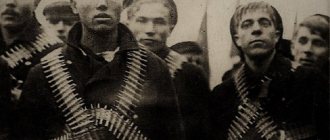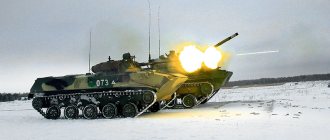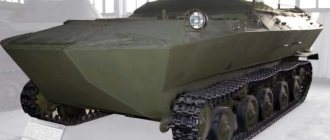To defeat infantry, destroy strongholds, and destroy enemy technical equipment, the USSR created the Grad MLRS.
See also the article BMP-2 infantry fighting vehicle and its technical characteristics
The mobility of the installation, the preparation time for firing, and the range of hitting targets ensure high effectiveness of combat use. Currently, it is in service in many countries around the world. It has been successfully used in local wars, including civil conflict in the East of Ukraine.
MLRS "Grad"
History of the creation of the BM-21 "Grad"
The use of the principle of launching ammunition along guides to deliver means of destruction has been used since ancient times. The following events represent the story:
- A similar type of installation, in the form of a single-axle charioteer, on which a shield with recesses to direct the movement of arrows was placed, appeared in the fifteenth century on Korean soil during the reign of King Sengjong the Great. The warhead consisted of ignited tips, the launch was carried out by igniting a powder charge, the firing range did not exceed five hundred meters.
- In the nineteenth century, the British Army used a more advanced version of this installation. At the same time, the flight range of the warhead was increased, but the shooting accuracy did not allow targeted fire, and the bulky design limited maneuverability.
- During World War II, the work of Soviet engineers made it possible to create the well-respected BM-13 Katyusha rocket launcher. It became the basic design on the basis of which the Grad military equipment began to be created.
- In 1960, NII-147, in accordance with the requirements of the leadership of the USSR Politburo, began developing the design of a new generation multiple launch rocket system and ammunition for it.
- 1963 - the prototype M-21 successfully passed tests, as a result of which the declared performance characteristics of the Grad were confirmed, the multiple launch rocket system was put into service in the USSR Ministry of Defense.
- 1964 - mass production organized.
Combat vehicle "Grad 21" (BM-21)
Over the past time, the Grad multiple launch rocket system has been repeatedly used in local conflicts and has shown its effectiveness in any field conditions.
See also the article ZPRK Pantsir-S1 and its technical characteristics
Historical reference
This masterpiece of military-technical thought owes its appearance to the Ural Research Institute under code number 147. In 1957, the need arose to create a new type of combat vehicle that would combine the advantages of an all-wheel drive all-terrain vehicle and a maneuverable salvo launcher.
The choice fell on a group of scientists led by the then luminary of engineering, Alexander Ganichev. It was they who managed to develop such a projectile, which had the following advantages:
- The presence of folding blades, unique for that time, made it possible to place several dozen projectiles on the installation;
- A new method of manufacturing the body by drawing under high temperatures;
- The movement of each launched “rocket” is stabilized by rotation (provided during launch) and thanks to excellent aerodynamic characteristics (provided by the presence of wings).
- The powder charge is also marked by innovative ideas and was developed by several domestic research institutes at once.
The resulting vehicle entered service instead of the outdated BM-14.
Description of the Grad 21 combat vehicle
The Grad 21 combat vehicle with one full salvo (40.0 rounds) is capable of destroying manpower, light fortifications, equipment in open areas and in enemy caponiers over an area of approximately 7.2 hectares, with a dispersion up to 130.0 meters in depth, 200.0 meters along the front .
7.2 ha
approximate area affected by a full salvo of "Grad 21"
One BM-21 Grad installation includes the following:
- platform based on ZIL-131, Ural-375D;
- rockets (two-stage powder rockets "Grad") 122.0 mm;
- GAZ-66 platform with 1V110 Bereza control center;
- vehicle providing ammunition and loading weapons.
Design
Design features are presented as follows:
- on the Ural chassis, in the cargo part, artillery weapons are installed, including 40.0 guides for launching missiles (four rows of ten pieces each);
- the guides are mounted together with the turning mechanisms, lifting device, sight and other technological equipment;
- aiming is carried out by changing the position of the guide block using electric drives (vertical - 0.0-55.00; horizontal - 70.00 to the right, 102.00 to the left);
- launches are controlled from the cabin or remotely - along a radius at a distance of up to 50.0 meters;
- one salvo of a full Grad artillery package fires in 20.0 seconds;
- The speed of movement of the BM-21 can be 90.0 km/h.
Drawing of the Grad MLRS on the Ural-375 platform.
Modern models (in accordance with the modified performance characteristics of the BM-21) are equipped with missile launch control systems that allow aiming using satellite coordinates while moving, directly from the Ural cockpit.
Tactical and technical characteristics of BM-21 "Grad" (MLRS performance characteristics)
The main characteristics of the Grad MLRS are presented in the following table:
| Weight without loading and personnel, kg | 10870 |
| Weight when ready for launch, kg | 13700 |
| Length, m | 7.35 |
| Width, m | 2.4 |
| Height, m | 3.09 |
| Caliber, mm | 122 |
| Guides, pcs. | 40 |
| Minimum target engagement distance, m | 3000 |
| Maximum target engagement distance, m | 20400 |
| Area of continuous damage, hectares | 14.5 |
| Elevation angle, degrees | 55 |
| Crew, man | 3 |
| Combat position, minutes | 3.5 |
| Volley, time, seconds | 20 |
| Travel speed, km/h | 75 |
| Maximum march range, km | 750 |
Information about the performance characteristics of the BM-21 "Grad" is systematized using open sources.
Combat use
During the period of hostilities, the active use of the Grad MLRS complex made it possible to effectively solve tactical tasks of suppressing firing points and destroying enemy units:
- in 1969, when resolving disagreements with the PRC regarding Damansky Island, an armed conflict arose on the border with China, and it was captured by the enemy, but the use of Grad made it possible to reduce losses by clearing the territory with high-explosive charges;
- 1975-1976 _ in an armed conflict on the territory of Angola, the installation was successfully used to destroy columns, as well as clear areas fortified by the enemy;
- the use of "Grads" in the performance of international duty in Afghanistan was characterized by the fact that the installation was used for direct fire;
- when carrying out the anti-terrorist operation in the Chechen Republic, the installations were used to hit targets in hard-to-reach, mountainous areas, as well as places where militants were massively deployed;
- BM-21-1 was widely used in local conflicts in Karabakh, Ossetia, Somalia, Syria and Libya;
- Since 2014, it has been used in the civil war in Ukraine, where the use of a rocket launcher has been recorded on both sides of the conflict.
Combat launch of the Grad MLRS
It should be noted that since the seventies of the last century, Grads have been exported to more than seventy countries around the world, within the framework of military arms supply agreements.
Training
We have: Our own training program. The only equipped training ground in Udmurtia. Fenced and illuminated area with convenient parking. Individual approach to the client. Passing tests according to the approved standards of the Russian Cynological Federation. Experience in correcting the behavior of “problem” dogs.
Exhibition training
Preparing dogs for exhibitions - teaching how to properly display a dog in the ring and exhibition stand.
Developing the necessary minimum obedience and a calm attitude towards the inspection of a dog by strangers.
If necessary, classes are conducted on a treadmill, and equipment is used - balls, stands, hemispheres, etc. – to increase and strengthen the physical fitness of your pet.
Classes are taught by the most experienced specialists of our center -
Buldakova Inga Vasilievna 89124601614 and Shilova Valeria Anatolyevna 89501530639
Cost of 1 lesson - 500 ₽ (by appointment only)
Basic obedience course for owners of medium and large breed dogs
Our course was developed taking into account 20 years of experience in working and training dogs in various types of training. We formulate optimal solutions in training dogs during classes for each course participant.
During the basic course, the emphasis is on practicing the necessary commands that are needed for comfortable living with a dog in the city: “Nearby”, “Sit”, “Lie down”, “Stand”, “Place”, staying in place, distrustful attitude towards food on the ground and in the hand of a stranger, etc.
The course also includes classes on correcting the behavior of “problem” dogs: aggressive behavior towards surrounding animals, people, children; disruptive behavior at home; socialization and training to calmly relate to the environment, etc.
Classes are held 2 times a week - the days of classes are determined at the org. meeting, under the guidance of licensed instructors of the Russian Canine Federation and athletes of the Armory City CC.
The course is designed for 16 lessons
Total cost of the course – 10400 ₽
Basic obedience course for owners of medium and large breed dogs - Level 2
In this course we will teach you and your dog new commands that were not included in the “Basic Obedience Course 1st Stage”, as well as repeat those commands that your pet already knows.
When working with a dog, we will increase the distance and intensify the work on concentration.
This course is suitable for dog owners who have already completed the “Basic Obedience Course” and would like to teach their pet new commands, as well as improve control of the dog, and perhaps take the first step towards passing the tests approved by the Russian Canine Federation.
The course is designed for 16 lessons.
Total cost of the course – 10400 ₽
Basic obedience course for small breed dog owners
This course will appeal to owners of small dog breeds, such as Yorkshire terrier, miniature pinscher, toy terrier, bichon frize, lapdog and others.
You will receive the basics of managing your pet and form the necessary rules of behavior for him, no matter where he is: in an apartment, in a house, in a car, on the street, etc.
Classes are held 2 times a week (days of classes are determined at the organizational meeting), under the guidance of licensed instructors of the Russian Canine Federation and athletes of the Arms City CC.
The course is designed for 10 lessons.
Total cost of the course – 7200 ₽
Individual obedience lessons
As part of individual lessons with the dog owner, we find solutions to correct the behavior of his animal that is “uncomfortable” for the owner, and also teach him how to properly treat his pet.
We find solutions to direct your pet’s energy in the right direction and can reorient it to socially useful activities.
The cost of 1 lesson is 1000 rubles. (by appointment only).
Subscription (10 classes) – 8000 ₽
Sports group
This obedience group is for the enthusiast, taking into account your skills and the excellent obedience of your dog:)
The main focus of working with a sports group is preparing the dog owner to pass tests and participate in competitions according to the standards of sports and applied dog breeding: OKD - General training course, VN - Companion Dog, Obedience, IGP (obedient section)
Number of classes (month) - 8 (subscription).
Cost – 3200 ₽/month
Protective Service Training
Necessary for dogs of service and sporting breeds!!!
As part of the training, dogs acquire the skills to work correctly with a “stranger” person: bite with a “full” mouth, hold the “intruder,” fight and defeat him, pursue and not be afraid to go “ahead.”
The number of lessons is determined for each dog individually, but not less than 20 lessons (to prepare for passing the ZKS or IGP tests)
Training takes place on the sleeve and on a full protection suit
Cost of 1 lesson per sleeve – 800 ₽
Cost of 1 lesson per costume – 1000 ₽
Cost of training with 2 (two) participants:
– sleeve 1200 ₽
– suit 1500 ₽
To plan the scope of work for each lesson, pre-registration is required!!!
As part of protection classes, we prepare dogs and handlers (if there is such a need) to pass protection tests and participate in competitions - ZKS, RUSSIAN RING, IGP (formerly IPO
Pension
This service is provided for those dog owners who would like to teach the necessary commands to their pet in order to have an obedient dog at home, but, for a number of reasons, do not have the opportunity to train in a group or individually in our center.
Also, as part of the Boarding Board, we prepare the dog to pass the RKF tests in obedience, protection and tracking.
Conditions: Your pet is kept in our center in comfortable aviary-type boxes, measuring 1.5x3 meters, with heating in the winter, with daily walks (3 times a day) and mandatory training in obedience, tracking work or protective service.
Depending on what you need: either just training in obedience, or preparation for passing tests and participating in competitions, the minimum period of training with a dog is 4 months. (as a rule, dogs must be at least 1 year old to prepare for testing)
The conditions of the classes and the procedure for keeping and training the dog are discussed with the owner when concluding an agreement for this service.
Price:
Obedience training – 45,000 ₽/month
Obedience and protective service training – 55,000 RUR/month.
Obedience and tracking training – 55,000 RUR/month. (including on-site classes in the “fields”)
Modifications of combat vehicles
The combat use of rocket systems made it possible, based on the characteristics of the tasks performed by artillery units, to improve the characteristics of the BM-21 Grad (TTX) and develop modified models of military equipment, including:
| Modification | Features, individual parameters |
| 9-K-51 "Grad" - basic model |
| 9-K-51-M "Tornado-G" - firing range up to 40.0 kilometers |
| 9-K-54 "Grad-V" - lightweight model (12.0 guides, GAZ-66 platform for airborne units) |
| "Grad-V-D" - tracked platform "Grad-V", transportation of ammunition and loading is carried out from the BTR-D base |
| 9-K-55 "Grad-1" - model with 36.0 guides. Transportation of ammunition and loading is carried out by 9T450 on the ZIL-131 platform. Used by regiment artillery in the interests of special units during targeted operations |
| 9-K-55-1 "Grad-1" - a platform on the Gvozdika chassis. 36 guides, ammunition delivery and loading on the MT-LB platform |
| 9-K-59 “Prima” - represents models with increased enemy firepower. 50 guides. High cross-country ability of the platform |
| Grad-1A "BelGrad" - Belarusian modernization. Platform MAZ-6317-05. Served by a staff of six people. The reserve ammunition is sixty units. The time to bring into combat readiness after firing is at least six minutes. Cruising range 1200.0 km, speed no more than 85.0 km/h |
| "Bastion" is the result of modernization by Ukrainian developers. The Grad artillery is used on the KrAZ chassis |
See also the article Military equipment “Gvozdika” and its characteristics
This is not a complete list of upgrade options. Over time, control and guidance systems, the use of base platforms and other structural components and mechanisms have undergone changes.
Foreign analogues of the Grad system
Official permission for the production of the BM-21 artillery base was received only by the Czech Ministry of Defense. Despite this, there are many cases and attempts to copy the technical characteristics of the Grad system and introduce them into their own military equipment. The leaders of outright plagiarism are reactive installations:
- MLRS "FIROS" made in Italy. In service since 1981. But the main goal was to equip units of the UAE and Libya. The warhead is placed classically - on the rear of a three-axle vehicle platform, on a rotating mechanism. Tactical and technical characteristics are presented - two groups of 20.0 guides each, caliber 122.0 mm, aiming angle below those of the domestic "Grad". Some samples were equipped with light armor protection. The total mass of the equipped installation is at least 17.3 tons. There were cases of spontaneous detonation of ammunition. The official reason is non-compliance with storage temperature conditions. In 1996 it was discontinued by the manufacturer.
See also the article Armored car Kombat T98 its technical characteristics
MLRS "FIROS"
- MLRS T-122 “Sakarya” is a hail-breaking version of Turkish developers. To this day it is used as the main tactical weapon of the country. Over time it is constantly modernized. Recently, the guidance, opening fire and control systems have been changed. The time required to get into firing position after firing (reloading) has been reduced due to the use of polypropylene containers used simultaneously for transportation and firing.
MLRS T-122 "Sakarya"
- BM T-122 of German developers. The vehicle base “MAN” (6/6) is used as a vehicle platform. The warhead consists of two packages of 20 guides. The hardware controls aiming using electronic control systems. The latest modernization has made it possible to use missile containers made of composite materials. Aiming angles are smaller than those of the Grad. Guidance is carried out from the cockpit, which can withstand the effects of weapons of mass destruction and is equipped with light armor. Additional weapons - a 7.62 mm machine gun on the roof of the crew - the gunner can use it without leaving the protected part of the cabin.
BM T-122
At the same time, according to foreign experts, modern performance characteristics of the Grad MLRS have significant advantages over foreign models of similar weapons.
Ammunition for "Grad"
The Grad uses ammunition that consists of three main parts:
- The combat component is the active explosive part, which is designed to destroy enemy forces.
- The engine is built on the reactive principle (the same as any spacecraft). In turn, it consists of a container with fuel and devices for “ignition” and removal of burning gases.
- Stabilizer – for better flight quality and range.
In the mid-50s, the range of ammunition weighing just over 60 kg did not exceed a couple of tens of kilometers. To strike a close object, the shells were hung with special rings: the closer the enemy was, the more rings were required.
Conveyor production of ammunition was established in the 1960s. Since then, Soviet engineers have created numerous varieties of them with various useful qualities:
- Chemical damage;
- Creating a massive smoke screen that actually “blinds” the enemy;
- Radio communication failure;
- Destruction of anti-tank bombs.
Firing tables BM-21 "Grad"
| Name of ammunition | Rocket weight, kg | Weight of the performing part, kg | Mass of explosive, kg | Flight range, km |
| 9-M-22 high-explosive fragmentation (HE) | 65.72/66 | 18.4 | 6.4 | 5.0/20.4 |
| 9-M-22-U-1 (OF) | 66.6 | 18.4 | 6.4 | 5.0/20.4 |
| 9-M-28-F (OF) | 56.5 | 21 | 6.02 | 4.0/15.0 |
| 9-M-521 (OF) | 66.0 | 21 | 15.0/40.0 | |
| 9-M-522 (OF) | 70.0 | 25 | 4.5 | 8.0/37.5 |
| "Threat-1-M" (controlled) | 66 | 21 | 5,0 | 1,6..42 |
| 9-M-22-S (incendiary) | 66.0 | 17 | 5.94 | 1.5/19.89 |
| 9-M-28-S (incendiary) | 53.0 | 17.8 | 5.94 | 1.65/15.07 |
| 9-M-28-D (propaganda) | 52.3 | 17 | 0.142 | 1.65/15.42 |
| 9-M-42 (lighting) | 27.0 | 10.0/5.0 | ||
| 9-M-519 (interfering) | 66.0 | 18.4 | 4.5/18.3 |
Information about the BM-21 Grad firing tables is taken from publicly available sources.
The combat equipment and characteristics of the Grad multiple launch rocket systems, which are in service with the Army of our country, fully comply with the requirements for conducting artillery attacks to solve both tactical and strategic tasks.
Foreign manufacturers will not be able to reach the level of modern MLRS “Smerch”, “Uragan” and other similar systems for a long time.
See also the article Multiple launch rocket system "Smerch" and its performance characteristics

